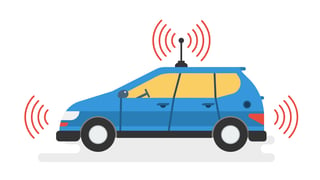 Imagine, if you will, a world in which you can do, in a car, all the things you’re not supposed to do while driving: talking on your phone, texting, watching “Laverne and Shirley” reruns, putting on makeup, playing the trombone, etc. You will be able to do those things because you won’t actually be driving the car; the car will drive itself to your destination.
Imagine, if you will, a world in which you can do, in a car, all the things you’re not supposed to do while driving: talking on your phone, texting, watching “Laverne and Shirley” reruns, putting on makeup, playing the trombone, etc. You will be able to do those things because you won’t actually be driving the car; the car will drive itself to your destination.
And the promise of self-driving cars doesn’t stop with increased productivity (or goofing off).
Benefits of Self-Driving Cars
Among the benefits of a world of autonomous vehicles are:
Fewer traffic accidents. It turns out that humans, as a group, aren’t very good drivers. They make bad decisions (or no decision), resulting in countless deaths, injuries, and property damage every year, not to mention overburdened police and courts. Self-driving cars will always be alert and courteous, and will be able to detect and process information about the road ahead faster than any human driver.
Shorter commute times. Because traffic will be governed by robot cars, not human drivers, the cars will be able work together to optimize the flow of traffic. Some proponents even envision a future without the need for traffic lights—the vehicles will organize and optimize turn-taking at an intersection by communicating amongst themselves, not by referring to an external controller.
Less energy waste. The shorter commute times will result in less fuel wasted by sitting in traffic.
Are We There Yet?
Although you have probably heard about recent developments in self-driving cars by companies such as Waymo (part of Alphabet, the parent company of Google), Uber, Tesla, and the traditional automobile manufacturers, we still are a long way from self-driving utopia. The current generation of autonomous cars are still mostly experimental; none are ready for consumer use. They do fairly well in ideal conditions, such as sunny days with little traffic in areas that are meticulously mapped. Their performance falls off fast in rain, snow, darkness, and unfamiliar territory.
The main technical hurdles are related to software and communications, and to a lesser extent, hardware such as sensors, processors, and actuators.
Hardware: Great strides have been made in the sensors that autonomous vehicles will need to detect objects in the world around them. Video, GPS, radar, and LiDAR (similar to radar, but using laser light instead of radio waves) will soon mature, if they haven’t already, to the point where they are reliable and cost-effective enough to be used in production automobiles. The actuators (motors and related hardware) that will propel, brake, and steer the cars are off-the-shelf components already.
Software: Detecting the world around a car is one thing; making sense of what the sensors are saying, and making split-second decisions on that basis, is exponentially more difficult. This is where software comes in, and a good deal of the software that goes into the self-driving cars of the future will rely on machine learning. The software will have to be blazingly fast and utterly predictable and reliable.
Communication: We know that new types of wireless communication networks will be needed, but there is less certainty about what form they will take. Some researchers have proposed vehicle-to-infrastructure networks, in which cars “talk” with roadside devices regarding traffic and other conditions. Others believe that self-organizing vehicle-to-vehicle networks would be more reliable and less expensive, especially in rural areas with less infrastructure. Either approach, or some combination of them, requires much more research and development.
Destination
There are other challenges as well, such as legal and regulatory (if there is an accident, who’s responsible?) as well as social (how soon, if ever, can we eliminate the human-driven cars so manufacturers can focus less on accommodating their unpredictable ways?) and economic (will people own their self-driving cars, or will there be fleets of shared cars available, and you just ask for one when you need it?).
Regardless, we at AndPlus, with our expertise in creating simple interfaces for complex software/hardware systems, stand ready to contribute to simplifying the operation and management of these new transportation modes. We’re looking forward to a super-cool, super-efficient self-driving future.
















